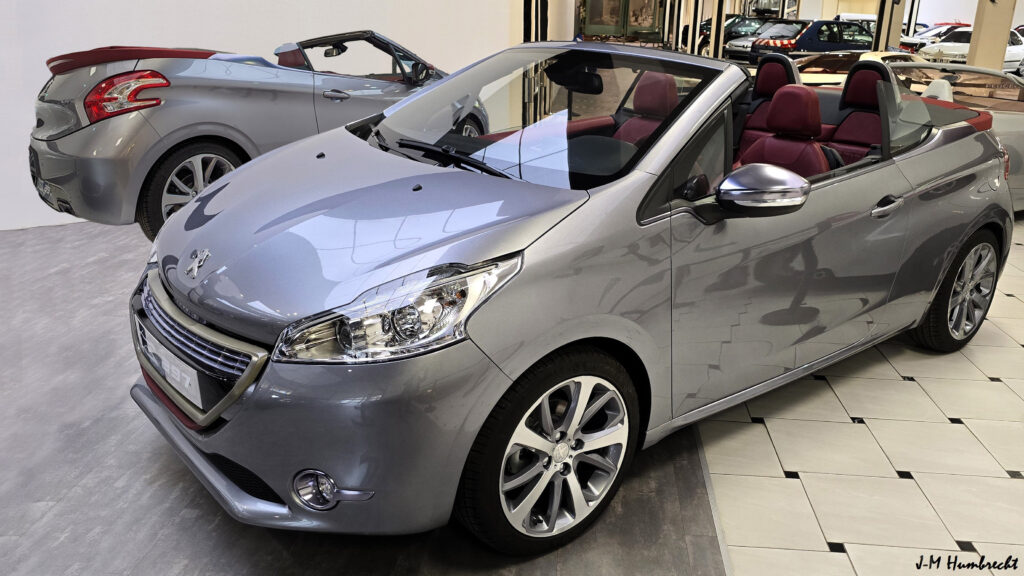- A secret prototype for a soft-top 208 Cabriolet was recently revealed at the Peugeot museum in France.
- Unlike its hardtop predecessors, the 208 Cabriolet aimed to bring back the classic canvas roof configuration for better proportions, rear passenger space, and potentially lower costs.
- Development started in 2007 but the project was scrapped due to high development costs compared to the similar DS3 Cabrio with a smaller folding roof.
Cancelled automotive projects hold a certain charm, particularly when they involve life-sized prototypes that remained hidden behind closed doors for years. Such is the case with the Peugeot 208 Cabriolet you see pictured here and which was recently exhibited in France. It offers a glimpse of what could have been, had the company’s executives given it the green light for production.
The only Peugeot 208 Cabriolet in existence was shown for the first time at the Musée De L’Aventure Peugeot in Sochaux, France. Development of the “A97” project began in 2007, five years before the debut of the original Peugeot 208 hatchback which arrived in 2012.
More: The Renault 5 Would Make For A Très Chic Cabrio, But It Won’t Happen
Unlike its predecessors, the 206 CC and the 207 CC, which featured retractable hardtops, the cabriolet version of the Peugeot 208 was intended to bring back the soft top configuration. The French brand acknowledged the packaging, cost-saving, and weight-saving benefits of this solution.
As exhibited by the prototype, a more traditional canvas roof would allow more balanced proportions, doing without the coupe features of the previous iterations. It would also allow more room for the heads and the knees of rear passengers, making the interior feel less cramped.
The roof mechanism was reportedly developed by Austrian company Magna Steyr, which was responsible for the production of the Peugeot RCZ. The red canvas roof of the prototype matched the leather-upholstered interior, featuring a glass rear window and an integrated third brake light.
Musée De L’Aventure Peugeot
The rest of the bodywork appears to be largely shared with the three-door hatchback, further reducing development costs. Besides the lack of the roof and the frameless windows, the Peugeot 208 Cabriolet prototype features a bespoke rear end with a heavily sculpted tailgate and a new rear bumper.
Cancelled For A Good Reason
According to French media L’Argus, the A97 project was initiated by three individuals without the approval of the now-defunct PSA Board, which has since been replaced by Stellantis. These included Jean-Pierre Ploué, who was the head of design at PSA Group (now the design boss at Lancia), Gilles Vidal, who served as Peugeot’s head of design (now the design boss at Renault), and Xavier Peugeot, the head of marketing (now the vice president of Commercial Vehicles at Stellantis).
The museum told us that the project didn’t come to fruition due to the “restructuring and rationalization carried out by the PSA Group at the time.” The project was shelved in 2011, in favor of the similarly-sized DS3 Cabrio sibling. The latter debuted in 2012, employing fixed pillars and a much smaller canvas roof. This solution led to significantly lower R&D costs compared to a full convertible.
According to inside sources, production of the DS3 Cabrio required an investment of €50 million, which was four times lower compared to the Peugeot 208 Cabriolet. This makes a huge difference in savings, especially when we consider the low sales potential of a drop-top urban dweller. Currently, the only representatives of the segment are the Mini Convertible and the Fiat 500e Cabrio.
Where Can You See It
If you happen to be in France, you can check out the Peugeot 208 Cabriolet, and other interesting concepts, in person at the Musée De L’Aventure Peugeot in the city of Sochaux. Peugeot’s Style & Design exhibition will remain open to visitors until September 22.
Another intriguing and previously unseen prototype is the white Peugeot RCZ Cabriolet, which also failed to make it to production. This model features a canvas top, departing from the distinctive bubble glass roof of the production-spec coupe.
On a failli avoir une 208 cc ! Quel dommage, un peu de taff sur l'arrière mais sinon ça aurait été très sympa 👌 pic.twitter.com/G9yWiwJiJD
— BenjiBurn (@BenjiBurn) March 22, 2024













